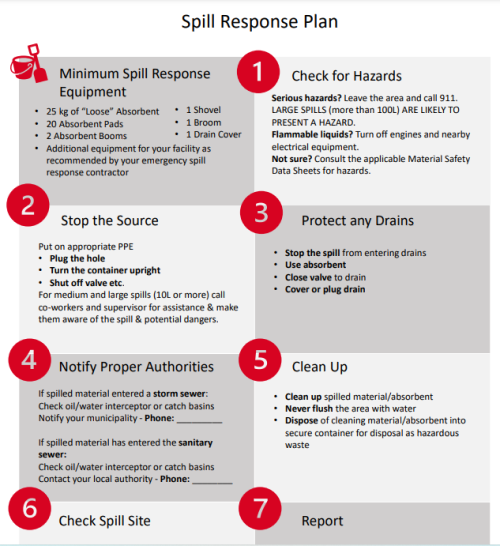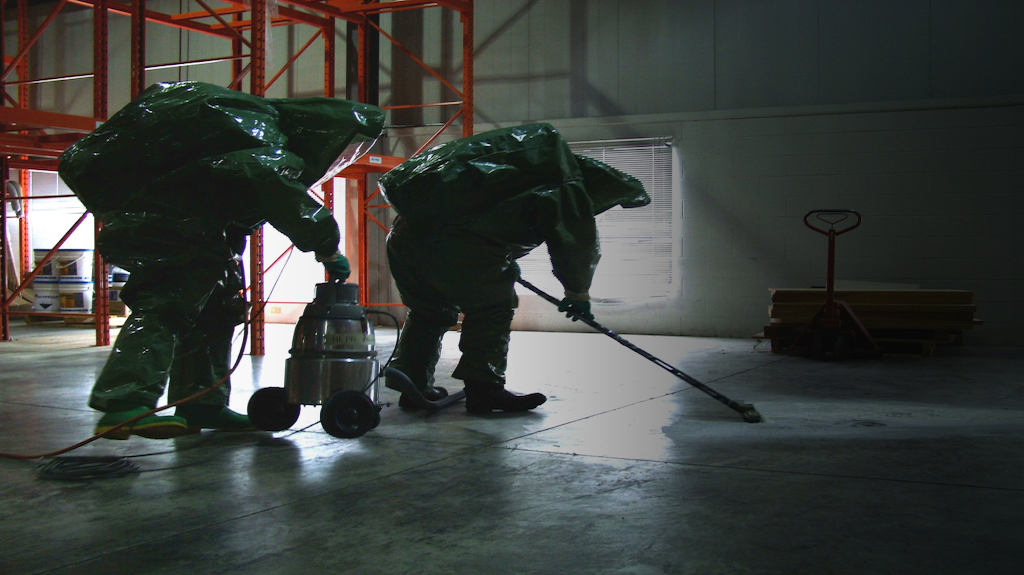A spill response plan template is an essential tool for ensuring a safe and effective response to accidental spills, leaks, or releases of hazardous and non-hazardous materials.
It helps minimize potential harm to people, property, and the environment by providing clear steps to contain and manage spills quickly. Implementing this plan protects both your employees’ health and the surrounding environment.
*Note: By filling in the form you are consenting to be added to our bi-monthly email that will inform you of upcoming training courses and other helpful health and safety information. You can unsubscribe to this email at any time.

Why You Need a Spill Response Plan

Accidental spills can happen at any time – whether from equipment failure, human error, or unforeseen events. Having a spill response plan in place ensures your organization is prepared to act quickly and effectively when they do.
A well-developed plan provides clear procedures for containing, cleaning up, and reporting spills, reducing the risk of injury, environmental damage, and costly downtime. It also ensures compliance with environmental regulations and workplace safety standards, helping you avoid fines and legal issues.
Beyond compliance, a spill response plan demonstrates your organization’s commitment to protecting employees, the community, and the environment. It promotes awareness, accountability, and preparedness—key factors in preventing small incidents from becoming major emergencies.
Spill Response Plan FAQ (Canada)
1. What is a spill response plan in Canada?
A spill response plan is a documented procedure that outlines how to respond safely and effectively to accidental spills, leaks, or releases of hazardous or non-hazardous materials. It provides clear steps for containment, cleanup, communication, and reporting. In Canada, these plans help organizations comply with the Canadian Environmental Protection Act (CEPA) and applicable provincial regulations such as the Ontario Environmental Protection Act.
2. Why is spill response planning important for Canadian workplaces?
Spill response planning is essential because it protects workers, the public, and the environment from harm. It ensures compliance with federal and provincial legislation, including CEPA, WHMIS, and local environmental standards. A proactive spill plan also reduces liability, limits environmental damage, and minimizes costly downtime and cleanup expenses.
3. Who is responsible for spill response in the workplace?
Employers are responsible for creating and maintaining an effective spill response plan, as well as providing proper training to employees. Workers who handle, store, or transport hazardous materials are expected to follow the plan, wear appropriate personal protective equipment (PPE), and report spills immediately. Partnering with certified training providers like ACUTE Environmental & Safety Services helps ensure everyone understands their roles and responsibilities.
4. What should a spill response plan include?
A comprehensive spill response plan should outline:
-
Procedures for containing and cleaning up spills
-
Emergency contact information
-
A list of available spill response equipment and PPE
-
Defined employee roles and responsibilities
-
Notification and reporting steps
-
Post-incident review and prevention measures
Using a spill response plan template and completing ACUTE’s spill response training can help your organization develop a plan tailored to its specific hazards and operations.
5. How can ACUTE’s Spill Response Training help my organization?
ACUTE’s Spill Response Training gives employees the knowledge and hands-on skills needed to manage spills safely and effectively. Participants learn how to identify hazards, use containment tools, and follow regulatory reporting procedures under WHMIS and CEPA. The training also includes practical, scenario-based exercises so your team is fully prepared to respond quickly and confidently in the event of a spill.
Looking for Spill Response Training?
For this course we can conduct the training at your facility or at our own training facility, whichever will suit your needs best. There are some great benefits to both approaches. By completing your training on-site we can save your staff travel time, by completing your training at our facility you can benefit from our spacious training room, our state of the art hands on training space and full use of our break room.
This training program will cover the legislative requirements and measures for spill reporting and cleanup. Participants will be taught practical strategies to both prevent and safely contain spills that occur in the workplace. Training programs are routinely customized to reflect client sites and products.
Who should enroll in this training program?
Employers, supervisors, workers, workplace spill response or emergency response team members, Joint Health and Safety Committee members, Environmental Managers and any worker who desires to learn safe, practical steps for spill response as well as gaining a deeper understanding duties under the Ontario Environmental Protection Act.
Training Program Duration
½ Day (4 Hours)
1 Day (8 Hours) – includes practical spill drills
Learn more here: Spill Response Training – Why Choose Acute?
What Our Customers Are Saying…
“The best place to get trained, period. The lessons include plenty of hands on components which definitely help retain the knowledge taught within the classrooms. Above all, the instructors know their stuff, they are all extremely knowledgeable and draw upon their own experiences to help engage the class. If I could give them higher than 5 stars, I would, and I would most definitely do my training refresher courses here again.”
“Knowledgeable and professional trainers that understand the practical applications of the material they teach. They were able to give me confidence to go and use my training – exactly what I wanted.”
“By far the best place for training. They offer several different types of training and are very professional.
I have been doing my joint health and safety committee training this week and could not be more satisfied. Patrick has been teaching the class and he’s an awesome teacher. He’s funny, knowledgeable and cares about what he’s teaching. So many classes like these can be boring and drag on but tomorrow is day 5 and I feel like the week flew by.”

